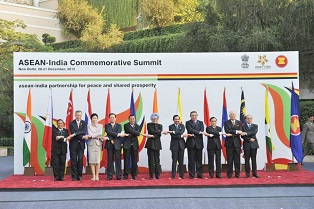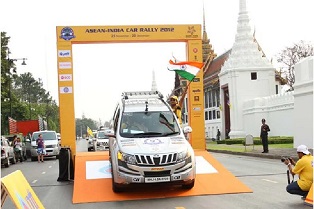By Archis Mohan
In recent times, an Indian tourist is more likely to travel to Thailand than anywhere else in the world. In 2012, a whopping 1.16 million Indian tourists visited Thailand.
But Prime Minister Manmohan Singh’s visit to Thailand on May 30-31 will anything but be touristy.
India and Thailand have over two millennia old religious, cultural and trade links. In the 1990s New Delhi’s ‘Look East Policy’ and Bangkok’s ‘Look West Policy’ converged to bolster economic and trade links. Since 2003, the relationship has blossomed to cover security and defence cooperation and negotiations are ongoing to ink a free trade area agreement. Some observers term the last two decades as the golden age of India-Thailand friendship.
However, much more needs to be done to improve connectivity and iron out the rough spots in signing of a full fledged FTA that has been under negotiation for nearly a decade now. Most of all, New Delhi and Bangkok need to further strengthen their security and defence cooperation given their geo-strategic compulsions in the region. The good news is that both Thai and Indian leaders are aware of the challenges ahead.
 That Thailand’s current PM Yingluck Shinawatra was the chief guest at 2012 Republic Day Parade and also attended the India-ASEAN commemorative summit in December in New Delhi is evidence of the seriousness that both India and Thailand accord their relationship. Indian Defence and External Affairs Ministers are slated to visit Thailand later this year, which shows the desire on the part of both countries to maintain the momentum in their relationship.
That Thailand’s current PM Yingluck Shinawatra was the chief guest at 2012 Republic Day Parade and also attended the India-ASEAN commemorative summit in December in New Delhi is evidence of the seriousness that both India and Thailand accord their relationship. Indian Defence and External Affairs Ministers are slated to visit Thailand later this year, which shows the desire on the part of both countries to maintain the momentum in their relationship.
There have been frequent reciprocal visits by Prime Ministers and senior functionaries of the two countries since 1990s after what is considered an ice-breaking visit of the then PM Rajiv Gandhi to Bangkok in 1986, followed by PM P.V. Narasimha Rao’s visit in 1993.
That India and Thailand are located in each other’s extended neighbourhood and share a maritime boundary in the Andaman Sea underscores the need for closer trade and defence ties.
This proximity offers immense potential for increased connectivity, particularly between India’s northeastern states and Thailand. New Delhi hopes greater connectivity with ASEAN of its northeastern states would help decrease the development deficit in these states.
Similarly, Thailand believes better connectivity could help increase the footprint of its businesses in foreign markets like India with the ASEAN expected to become the ASEAN Economic Community (AEC) by creating a single market in 2015.
 India and Thailand have good connectivity in the civil aviation sector with as many as 138 flights operating a week. India is looking at Thailand as an important bridge between South Asia and Southeast Asian hinterland. A trilateral project to construct a highway between India, Myanmar and Thailand is in the works and is likely to be completed by 2016.
India and Thailand have good connectivity in the civil aviation sector with as many as 138 flights operating a week. India is looking at Thailand as an important bridge between South Asia and Southeast Asian hinterland. A trilateral project to construct a highway between India, Myanmar and Thailand is in the works and is likely to be completed by 2016.
An India-Thailand Joint Working Group on Connectivity and Infrastructure had its first meeting in September 2012 to explore possibilities of cooperation with third countries, including cooperation on Dawei deep sea port and a special economic zone in Dawei, as also projects in Lao and Cambodia.
Thailand is making efforts to develop ports on its western seashore in the Andaman Sea. A Thai private company is to develop Dawei port in Myanmar as a gateway to India, West Asia and Europe. It has sought Indian help to assist Myanmar to work towards better connectivity from the Indian border to Dawei port.
Defence ties
Bangkok and New Delhi have also made good progress in strengthening defence, security and juridical cooperation. The two have signed agreements on mutual legal assistance; transfer of sentenced persons, and close to signing an extradition treaty. The two claim good cooperation between their law enforcement agencies, particularly in counterterrorism and transnational crimes. An extradition treaty is likely to be inked during Prime Minister Singh’s visit.
In defence, New Delhi and Bangkok have a broad-based engagement which comprises regular joint exercises/joint maritime patrols near the international maritime boundary to counter terrorism, piracy and smuggling; training of officers at each others’ Armed Forces Training institutions and exchange of visits at various levels.
Trade
Trade and investment relations have improved significantly after the two concluded the framework agreement on FTA in 2003. An early harvest scheme that came into force in September 2004 eliminated duties on 82 products.
Currently, the two countries are negotiating the final bilateral comprehensive FTA. Last of the 26 meetings of the negotiators was held in November. The Second Protocol to Amend the Framework Agreement for Establishing FTA between Thailand and India was signed during the visit of Thai PM to India in January 2012. The two PMs have directed their negotiators to conclude the FTA at the earliest.
Trade reached US$ 9.2 billion in 2012-13 and there has also been a fairly impressive growth in two-way investment flows between our two countries. Bilateral Trade has multiplied eight times since 2000.
Indian FDI into Thailand is estimated to be around US$ 2 billion since 1970s. Thailand has invested US$ 102.44 million in India. Leading Indian companies in Thailand include the Tata group with Tata Steel having invested in the largest Thai steel manufacturer Millennium Steel to create Tata Steel Thailand. The Aditya Birla group, Dabur, Lupin and NIIT are among other major Indian companies doing business in Thailand Thai companies in India have invested in the fields of Agro-processing, construction, automotive, engineering and banking have active and growing business presence in India.
Both countries are important regional partners linking South and Southeast Asia. They cooperate closely in the ASEAN, East Asia Summit (EAS) and BIMSTEC groupings as also Mekong-Ganga Cooperation (MGC) and Asia Cooperation Dialogue (ACD).
Cultural links
India and Thailand have cultural and religious that date back over two millennia.
In 329 B.C., Emperor Asoka sent Bhikkus Sona and Uttara to Suvarnabhumi to spread the message of Buddhism. Today, Buddhism is Thailand’s official religion and over 70,000 Thai tourists visited India in 2012 for pilgrimage. Ahoms, from north east, migrated to Thailand some 800 years back.
Elements from Hinduism are reflected in Thai architecture, arts, sculpture, dance, drama, mythology and literature. Both Pali and Sanskrit have influenced the Thai language. Ramakien, a Thai national epic is derived from the Ramayana.
The Pahurat district, a large fabric market, is Bangkok’s Little India. That it is adjacent to the Chinatown is a reflection of the potential of cooperation and competition between India and China in the South-East Asian region.
(Views expressed above are the personal views of the writer)
Read more:
Agreements signed during the State Visit of Prime Minister of Thailand (10KB)
(10KB)
